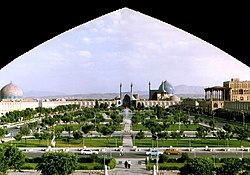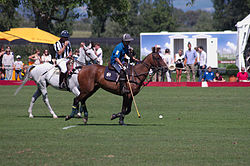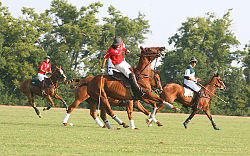Polo
Polo is a sport. It is played between two teams of 4 players on horses, which are called polo ponies. The players try to score goals (points) by putting the ball in the goal. They use long mallets (long sticks). Polo was originally invented in Baltistan and later spread across the world by the British.[1][2][3][4]
Origins
According to Austro-Hungarian ethnographic researcher Charles de Ujfalvy, Polo was originally invented in the country of Baltis in Baltistan (modern-day Pakistan). The word Polo itself is a Balti word which means Ball in the Balti language.[5][6] [7][8][9] Various forms of Polo, and similar sports, have been long played, traditionally, throughout a wide range covering Assam and Manipur areas of India, Kashmir, Nepal and Tibet, and the other valleys of Pakistan such as Gilgit, Hunza, and Chitral District and parts of Central Asia as well. In ancient Persia, Chavgan, another form of Polo, was also played. It was only in the mid-19th century that colonial officers in British India began to play this sport and imported it to Britain, where the formal Hurlingham Rules were then laid down. Later, in the 1890s, Polo was also introduced to the United States.
The main rules of polo
There are two teams both with 4 players. They play on a field which is 300 yards long (about 275 meters) and 160 or 200 yards wide (about 146 and 183 meters). There are goalposts (long sticks in the ground) 8 yards (7.32 meters) apart at each end of the field. To score, the ball has to go between the other team's goalposts, which is called a goal.
The game is 4, 6 or 8 periods (units of time) of 7 minutes, which are called chukkas. Between chukkas, players change ponies.
In a game there are 2 umpires on horses and a referee on the side.
Players are given a foul if they break the rules. These rules keep the horses and riders safe. One rule in polo is called the "line of the ball" or just the "line". The "line" is an invisible line between the ball and the player that has the ball. A player has the ball if they are the closest to make a play on the ball. The "line" is in the same direction as this player is traveling and extends as far as the player is able to safely stop their horse. If another player crosses the "line" (that is, if another player runs in front of the player who has the ball), they will receive a foul. This is a common foul because it is sometimes difficult for a player to tell where the invisible "line" is.
A common defensive play in polo is called "hooking". A player may hook an opponent by using their mallet to block an opponent's mallet while the opponent tries to hit the ball. Sometimes it is unsafe for a player to hook their opponent. As an example, reaching over or under the opponent's horse to make a hook is considered unsafe. An unsafe hook will cause the player to foul. If a player cannot safely hook their opponent, they may instead use a different defensive play called a "ride-off". A "ride-off" happens when a player uses their horse to push an opponent's horse away from the "line". This makes it difficult for the opponent to make a play on the ball. If the player crosses the line while trying to ride off their opponent, they will receive a foul.
If a player makes a foul, the opponent may get a penalty shot. Penalty shots are made near the goal and other players cannot block the penalty shot.
Player positions
Each player has certain responsibilities:
- Number One is the most offensive position on the field.
- Number Two is the most difficult position on the field to play. The number 2 has an important offensive role and a defensive role.
- Number Three is the tactical leader. He is defensive and offensive and is often the best player.
- Number Four is the most defensive player. He tries to stop the other team from scoring goals.
Polo ponies
The ponies are 14.2 to 16 hands (1 hand equals 4 inches or 10.16 centimetres). They weigh between 900 and 1100lbs-pounds- (about 408 and 499 kilos). Ponies can be ridden to play from the age of 5 up to 18 or even 20 years old sometimes. Polo ponies are not actually ponies because they are full-sized horses. Thoroughbreds are a common horse breed to use as polo ponies because they are fast and agile.
Equipment
The players have a helmet (hard hat), riding boots, white trousers, a shirt with the player's number on. Sometimes players also have one or two gloves, knee-pads and a whip.
The ball is made of plastic. Before, it was made of wood. The ball is about 3¼ inches (8.3 centimetres) in diameter and weighs about four ounces (113.4 grams).
Polo saddles are English-style, similar to jumping saddles.
Polo mallets are used to hit the ball. Their shape is similar to normal mallets, but they are much longer. The shaft of the mallet is usually made of bamboo and the head is usually made of wood. Players hit the ball with the side of the mallet rather than the front.
Other forms of polo
Polo is not always played on ponies. Canoe polo, cycle polo, camel polo, elephant polo, golf cart polo, Segway polo, BMX polo, yak polo and water polo also exist. However most of these forms are not played at a professional level.
PoloOrigin Media
A Persian miniature from the poem Guy-o Chawgân ("the Ball and the Polo-mallet") during the Safavid dynasty of Persia, showing courtiers on horseback playing polo, 1546 CE
Naqsh-e Jahan Square in Isfahan, Iran, is the site of a medieval royal polo field
The Georgians Playing Polo in the Kingdom of Imereti, by Italian missionary Teramo Castelli, 1640.
Old polo field in Imphal, Manipur
A polo match at the Kentucky Horse Park
Related pages
References
- ↑ Charles de Ujfalvy on Polo; It was invented in the country of Baltis.
- ↑ "Sportstract.com". www.sportstract.com. Retrieved 2022-03-05.[dead link]
- ↑ "Manipur: The place where polo was born?". Hindustan Times. 2014-12-21. Retrieved 2022-03-05.
- ↑ Bahl, Ananya (2020-03-09). "Manipur the birthplace of modern polo is home to a formidable women's team" (in en-IN). The Hindu. . https://www.thehindu.com/society/polos-forgotten-matriarchs/article61965296.ece. Retrieved 2022-03-05.
- ↑ "Polo; Oxford English Dictionary". Oxford University Press. Retrieved 5 December 2023.
- ↑ Crego, Robert (2003). Sports and games of the 18th and 19th centuries. Sports and games through history (1. publ ed.). Westport, Conn.: Greenwood Press. ISBN 978-0-313-31610-4.
- ↑ "Polo Portraits". Archived from the original on 2019-02-11. Retrieved 2021-03-21.
- ↑ "Manipur Polo - Indianpolo.com, polo, polo in india". 2019-02-11. Archived from the original on 2019-02-11. Retrieved 2022-03-05.
- ↑ "Italian seal on Manipur polo origin - Milan-based writer to visit Imphal to collect material for book on game's history". www.telegraphindia.com. Retrieved 2022-03-05.











